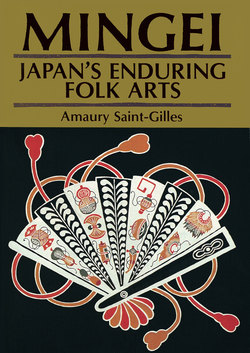Читать книгу Mingei: Japan's Enduring Folk Arts - Amaury Saint-Gilles - Страница 7
На сайте Литреса книга снята с продажи.
ОглавлениеINTRODUCTION
Folk art around the world has long captured my imagination. Whenever and wherever I visit another culture, I find it is folk art and handmade crafts that fill my suitcases to overflowing coming home. There’s something special about folk art — an almost indescribable aura that makes them appear so unique. Perhaps it is merely their lack of pretensions, but I think also their attraction has to do with the obvious care with which they have been crafted.
I cannot go further without taking a few lines to express my sincere appreciation to Mr. Okada Hiromu, President of Bingoya Craft Shop and to Mr. Shiga Naokuni, President of Takumi Craft Shop. Both of these learned gentlemen unstintingly gave their time and knowledge in helping me gather information for the initial articles. Without their expert help, the essays would have been nearly impossible to compile.
And once the series had ended it was the enthusiastic support of Ms. Koko Hashim of NYC and Mr. Kai Frost of John Wanamaker Philadelphia who saw the potential of making the collection of completed essays into a book, and assembling an exhibition of folk art based on these items.
By no means should this selection of 116 items be construed as the only remaining folk art in Japan. Far from it, as there are literally hundreds from which a choice had to be made. I selected initially on the basis of location, by picking one per prefecture moving from Hokkaido south to Okinawa. Then given full rein I skipped all over the islands picking up functional crafts, toys and the more misunderstood and pervasive ENGI (literally luck bringers). These often double as toys after their effectiveness has worn out and are given to children so whilst playing they (engi) can effect their protective powers.
Unfortunately some of the items I originally wrote about have already ceased to be. The two-part production of Hatta-yaki vessels are such an example, as are the “salt-spraying whale carts” of Nagasaki-ken. And others are waning as their markets narrow, and occasionally disappear almost before your very eyes. This trend has been somewhat reversed by a renewed interest in collecting mingei spawned by regular, impressive colour layouts in popular, leisure magazines catering to the travelling middle-class. A tourism orientation to be sure, but better than none as a market although crass commercialism of some items has done them in from that end of the scale. The biggest problem facing the makers of these unique items is teaching the craftsmanship needed for continued production to a ready and willing apprentice or relative. Many mingei have been passed from generation to generation for centuries, but the lure of a better life at better pay is creating havoc with this system.
I tried to compile this book to be as readable and useful as possible. Each item is illustrated either with a pen drawing or in a colour photograph. Most appear directly opposite written information about them, but colour printing costs forced me to gather photos together in one section. Each photograph is identified with its name and chapter number. Some items have, in addition to their illustrations, a colour plate showing special production methods, manner of use or even the way they are typically sold as is the case of Daruma. In the few instances I gave Japanese names, I listed proper family names first. And I have given the reader many Japanese words in the texts — most explained immediately and all others explained in a combined Index/Glossary at the back of the book. The locator map which directly follows this introduction is to give you some idea of the geographical spread of items selected. Prefectures are titled and chapter numbers relative to each are listed there. A guide to the colour closeups used on the cover is given with photo credits on page 260.
Meant to be compact, diverse and informative at the same time, I hope readers of MINGEI, Japan’s Enduring Folk Arts will enjoy journeying through this encapsuled world and perhaps gain a new perspective on the value of folk art as a result.
Intervening centuries fall away when one contemplates the pathos of little Hoko-san’s devotion or senses the romantic elegance of giving a raincape to your intended. Perhaps this small collection will help stem the destructive tides of change progress seems to bring in its wake, and thus help maintain the integrity of function and use that these many unique items are imbued with.
Tokyo, 1983
